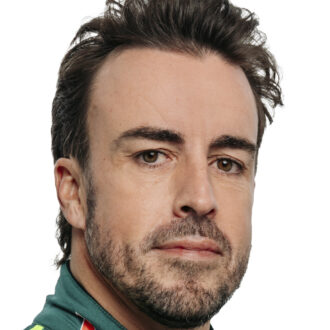Fernando Alonso and Lewis Hamilton: rivals reunited
Two prodigious talents, whose fortunes have been intertwined and opposed for over a decade. Andrew Benson looks at the rivalry between Fernando Alonso and Lewis Hamilton ahead of the British Grand Prix and asks: is there time for one final hurrah?
Getty Images
Sixteen years after they first got stuck into each other, Fernando Alonso and Lewis Hamilton once again find themselves contesting the same piece of track somewhere close to the front of Formula 1. For British fans, the prospect of witnessing the two drivers in such close proximity at Hamilton’s home race next month, so often the scene of on-track drama, marks a rivalry that has come full circle.

Smile and wave, boys: a team picture from Fuji, 2007. But the rot had already set in for McLaren
Getty Images
The routes they have travelled to return to this point could hardly be more different. Hamilton’s a somewhat unexpected fall from a place of grace that made him the most successful driver in F1 history through eight glorious years with Mercedes; Alonso’s a surprise leap back to competitiveness after a decade of purgatory in the midfield, or worse.
The stories of these two giants of motor sport were initially intertwined in a big-bang maelstrom of competitiveness, controversy and rancour, then ran in parallel for a time, before drifting apart. Now, the shifting sands of competitive forces, of team progression and regression, have brought them back together.
Before Mercedes’ monopolisation of F1, Alonso had 32 victories and two championships, Hamilton 22 and one. Hamilton’s career statistics look very different now; Alonso’s just the same. But as well as being outstanding, epoch-defining racing drivers, they remain also the most charismatic, most interesting and most quotable stars in F1.
As Hamilton’s worldwide fame grew, through success on track and his emergence as a campaigner for social and racial justice off it, so through his years of famine Alonso never lost his box-office appeal. Whether that was through forcing his McLaren to results it didn’t deserve, or entertaining antics such as taking to a lawn chair in Brazil when his car had ground to a halt for the umpteenth time.
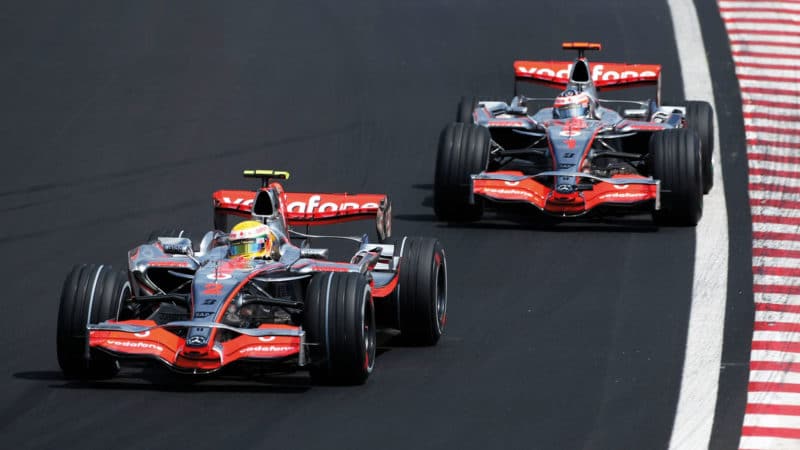
Fernando Alonso became irked by hotshot team-mate Lewis Hamilton, and fell out with McLaren.
All the while, they have been eyeing each other with guarded respect, each recognising in the other perhaps the only person fitting to be considered a true rival, at least until the advent of a young Dutchman called Max Verstappen. In turn, they were seen from the outside as two drivers whose careers would forever be inextricably connected, no matter how far their competitive destinies had diverged.
It took just half of the first grand prix of the 2023 Formula 1 season to remind the world what it had missed for much of the previous decade. The three laps in which they contested fourth place in the Bahrain Grand Prix were the greatest and most thrilling example of racing skills seen so far this year, climaxing with the best overtaking move.
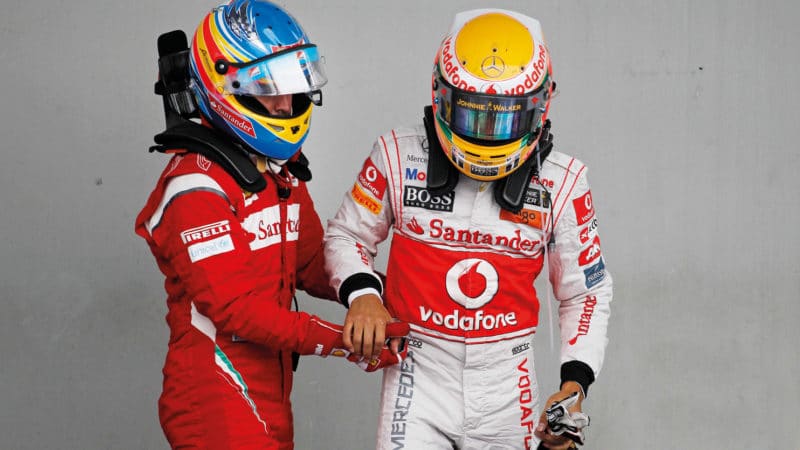
By 2011 both Alonso and Hamilton found themselves struggling
DPPI
Alonso, delayed by a messy first lap, was climbing back up through the field, Hamilton fading, clearly vulnerable. A first move by Alonso into Turn 4 floundered when, too greedy on the throttle in a car with which he was still unfamiliar, a kick of Aston Martin oversteer gave Hamilton’s Mercedes the chance to slip back past.
Next time around, Alonso’s canniness came to the fore. Lacking speed on the straight, he realised he needed to find a less obvious passing place. The one he chose was remarkable in improvisational audaciousness, a spot that is emphatically not known as a normal overtaking opportunity.
A better exit from the hairpin of Turn 8 and Alonso began to draw level with the Mercedes on the outside as they approached the curving braking point through 9 and into 10. Alonso feathered the throttle sufficiently to drop back just enough to enable him to dive back to the inside and claim the tightening corner.
“With both the best team radio and finest pass so far, Alonso was back”
“Yes!” Alonso said over the radio. A few laps later came another terrific overtake. Ferrari’s Carlos Sainz was wise to the move Alonso had produced on Hamilton, so more extemporisation was required. The same corner, but this time a wide entry, a cut-back on the exit, much earlier on the throttle and Alonso was past into the next corner, Turn 11.
“Bye, bye,” he said, now with the best radio transmission of the season so far in his pocket as well as the finest passing move. It was quite the way to announce he was back.
All that earned Alonso his first podium since – in one of his greatest-ever drives – he somehow dragged an Alpine into a genuine third place, beating a Mercedes and a Red Bull for pace, in Qatar in 2021. And that was his first podium since Hungary in his final season at Ferrari back in 2014.
While Alonso celebrated in Bahrain with the Red Bull drivers, Hamilton was talking to the media, contemplating a second consecutive difficult season ahead.
But while guaranteeing himself headlines with claims that Mercedes “didn’t listen” to his wishes in certain aspects of the design of its new car, Hamilton said something else, too: “I’m really happy for Fernando because he’s been here way longer than me and it’s good to have him back in the mix.”
They’ve had their moments, these two. Inevitably, after the intensity of their involvement in McLaren’s tumultuous 2007 season, when their competitive rivalry combined with the toxicity of the Spygate controversy – McLaren accused of stealing Ferrari secrets – to bring the team to its knees.
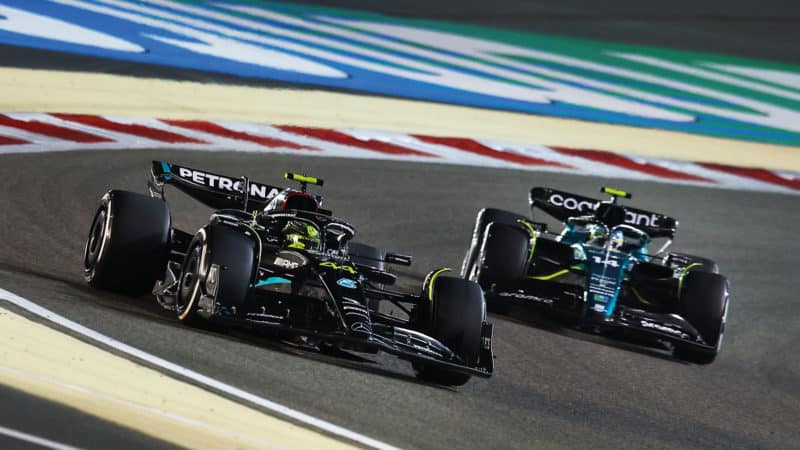
Hamilton and Alonso are once again locking horns – for a place on the podium
Getty Images
Since then, the occasional sniping has never stopped, all founded in their mutual recognition of each other’s ability, with a smidge of antipathy thrown in.
Last year, when they crashed together at Spa, Alonso said over the radio that Hamilton was an “idiot” who could “only race at the front”. He apologised and retracted later, but not before Hamilton had said in response: “At least I know what he thinks of me.”
A few weeks later, Alonso opined in an interview that some of Hamilton’s titles didn’t have the merit of others because he’d only had to race his team-mate. Hamilton responded by posting on social media a photo of the podium at Indianapolis in 2007, his arm around Alonso’s shoulder after he had held off his then McLaren partner for his second consecutive victory.
All good cut and thrust, the tone of each other’s remarks doubtless rooted in Alonso feeling he could and should have more titles than he has, Hamilton afforded the luxury of the magnanimity provided by his record-breaking achievements.
Behind it all, though, there is respect. They enjoy their on-track battles. They trust each other, know implicitly that the other will be hard but fair. In essence, they speak the same language out there, in stark contrast to the intense fight between Hamilton and Verstappen in 2021, when it was as if each was unable to understand the other at all, and didn’t fancy trying to either. From time to time, Hamilton references what he perceives as their contrasts. “I admire Fernando for his resilience,” he said in an interview in Austin last year, “because it takes a lot to come back. But we’re much, much different people, with much different values.”
It was the last question, and there was not time to ask him to expand on what he meant. But it surely has to be at least partly a reference to 2007, not least the nadir of their relationship in Hungary, when Hamilton double-crossed Alonso in qualifying, Alonso returned the favour, and then, in his anger at being singled out and penalised, threatened to blackmail the team by sending incriminating emails to the FIA.
“Alonso could have been at Red Bull, and won seven titles instead of two”
Hamilton has the word “loyalty” tattooed on his arm, and there’s no doubt that he is value- and fairness-driven. He prides himself on allegiance to people and brands, and being a leader-by-example in his group.
But it is easy to be loyal when you are the dominant figure in a team winning eight constructors’ titles in a row; harder when, as was the case with Alonso, you see one driver you believe you are way better than – Sebastian Vettel – sweeping all before them, and then another you believe you are every bit as good as taking over from him and doing the same.
Certainly, they have taken different approaches to their careers, Hamilton committing to just two teams, Alonso more peripatetic. But how might it have been had circumstances been different? Once Alonso had fallen out with McLaren – for which he certainly bears plenty of responsibility, but was far from solely at fault – and then made the fateful error of turning down an offer from Red Bull in favour of going back to Renault, his career trajectory was set.

“Idiot!” Alonso was scathing of Hamilton after the pair’s clash at Spa in 2022
Had that decision gone the other way, Alonso would have been at Red Bull for 2008 and 2009, and doubtless beyond. In that scenario, at least one senior figure at Red Bull believes, he would by the end of 2013 have won seven titles rather than just two – the four Vettel won, plus probably 2009 as well. Instead, it was his desire to go to Ferrari, remembering how it had dominated not long before with Michael Schumacher. Should he have known the team was beginning a decline from which it is yet to recover more than a decade later?
He still could have had two more titles, had bad luck not intervened in 2010 and 2012. But it was the helplessness of watching Vettel and then Hamilton in dominant teams which led to everything else.
The decision to extricate himself from his Ferrari contract two years early, having lost faith in the team’s ability to win a title; to allow himself to be convinced by a McLaren team in denial about its own lack of competitiveness, and a Honda underprepared for its F1 entry; to step away from F1 to pursue other ambitions; be tempted back by Alpine, whose lack of commitment to him led to the move to Aston Martin, which finally has proven to be a serendipitous choice.
Of course he could have handled himself with more patience and sensitivity at times –shouting “GP2 engine” over the radio at Honda’s home race might have made a point but caused long-lived upset. But as he put it to this writer last year, these were “rough times” and “a little bit painful”. His actions, however controversial at times, have always been rooted in a quest for competitiveness. All that frustration has been difficult to bear.
In their essence, their search for perfection, self-critical nature, competitiveness, introversion and inherent, fundamental shyness, perhaps these two share more than either might want to admit.

Sharing the podium in Australia this year. You have to go back to Qatar 2021 for the last time they appeared on one together.
“They have a huge amount of respect for each other – a huge amount of respect,” says former F1 driver Pedro de la Rosa, who knows them well. “Everyone has to speak to his own values, but both are very true people, very genuine people, if you go deep into them.
“One thing that is shocking is how family-oriented Fernando is. He is in constant contact with his father and mother. He takes them everywhere. He’s in contact with his sister as well. They try to see each other as much as they can. They fly together to races. I don’t think he’s any different to Lewis on the values. Their family values are very similar and they are both tough competitors but they want to win for the right reasons as well. They want to think they are the best at the track. They don’t want to win in an unhealthy manner.
“I think both of them are too similar, really, to be friends. They have just learned through the years to respect each other because they are very similar animals.”
De la Rosa has a unique perspective on Hamilton and Alonso. An ex-racer who has shared the track with them, and a shrewd analyst of drivers’ qualities, he has also worked with both extensively.
Test driver at McLaren with both in 2007 and then Hamilton until 2010, de la Rosa joined Alonso at Ferrari from 2013, and now works with him again as an ambassador at Aston Martin. There, underlining the depth of these relationships, he and Alonso find themselves with former McLaren team principal Martin Whitmarsh, who jokes that he has hired Alonso three times, fired him once, and been fired himself in the time they have known each other.
“They are very similar race drivers,” de la Rosa says. “But they tick for different things. Fernando has a more racing approach. Basically, he loves motor racing. It doesn’t really matter what type of car it is, as long as it has four wheels; he will always want to confront competitors and extract a lot of fun and love from it.
“Lewis loves motor racing as well, of course, but he needs to see a chance of winning otherwise he will not be in love for that long. Fernando’s life is motor racing and I think Lewis has developed other hobbies, other interests. It’s a different approach but the same common denominator.”
De La Rosa says he has been “very impressed” with Alonso’s approach at Aston Martin: “I hadn’t worked with him since Ferrari, so nearly 10 years. Coming back to Aston Martin, the way he’s done, how he motivates people, how he is interested in every little detail in the factory, of what people do. You can say: ‘Yeah, he’s more experienced and mature and therefore he’s acting to motivate people.’ No. He’s really behaving in a genuine way. If you act to motivate people, sooner or later they realise that you are not really interested. But he is.
“He’s just a very, very complete athlete right now. An incredible team player as well. I think that has happened because he has been in very uncompetitive cars, he has gone through really tough moments in his career, he’s been out of the sport, he’s been able to understand what motor sport is outside F1. We forget how difficult it is outside, how unsafe other categories are, other circuits, and then we tend to value more what we are doing.”
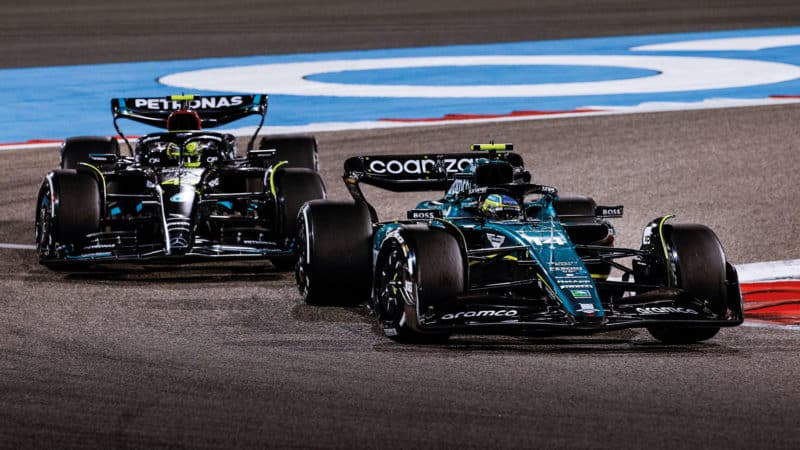
New pastures, mixed fortunes: Alonso leads the Aston Martin revival after a well-overdue positive career switch, while Hamilton and Mercedes have gone backwards in recent years
Getty Images
Alonso’s relationship with Alpine ended on a sour note last year, with him complaining about poor reliability and claiming the team lacked ambition. At the same time, from Alonso’s point of view, Alpine’s senior management let him down, by prevaricating on a contract, not offering him the two years he wanted and thereby showing a lack of trust and belief in him. At Aston Martin, he has not only found a more competitive car but also what he perceives to be a more purposeful environment.
“I am demanding in everything I do,” Alonso says. “I expect a lot from people I work with. I give 100% and I expect the same from the people I work with. Since the first day in Aston Martin, I felt the same values from the people around me.
“I know my time is not unlimited behind the wheel. We have the investment and the facilities and the talent, so it is just a matter of time. Unfortunately, I am not 20. But I will do my best to help the team.”
De la Rosa adds: “He’s now very excited by the fact the team is getting better and better and is ambitious. This is where he is feeling really comfortable, the fact that the team shares his ambition. Fernando can feel the change. They deliver what they say they aim for. They are really pushing. It doesn’t really matter whether we achieve the ultimate goal or not; the team is investing everything they can in achieving victory in the future. If it will be on time before he retires or not, it is something he doesn’t really care about, because as long as it happens, he feels he is at the right place.”
He turns 42 in July; how long can Alonso go on? Alpine, using the example of Schumacher’s ill-fated comeback, was worried the answer to that was not much longer – hence the offer of only a one-year deal with options that turned him against the team. So far, though, there is no sign of any waning of Alonso’s powers and de la Rosa, who races karts with him in their spare time, says: “He is as fast as ever. When a driver looks old, it means they are deteriorating in a similar manner inside, on their physical strength, explosive power, endurance, reflexes, eyesight. And he looks good, man. He is fit, he is taking care of himself, on nutrition, all the little details that possibly earlier on he was not paying so much attention.
“How long it will last, I don’t know. I think no-one knows. He doesn’t know. It will depend on his DNA. Some drivers, when they reach the age of 35, they really drop in speed. Others don’t. For sure it won’t be a massive drop-off and so far I haven’t seen any hint of drop-off from Fernando.”
At 38, Hamilton is three and a half years younger than Alonso. A few seasons ago, he said he could not see himself still racing when he was 40, but his position on that has changed, and for months he has been consistently saying that he will sign another contract with Mercedes before his existing one expires this year.
Toto Wolff, team principal at Mercedes, has said he would not resent Hamilton if he chose to leave the company that has been his life if it cannot provide him with a competitive car again in the next couple of years. But there seems little realistic prospect of Hamilton going elsewhere.
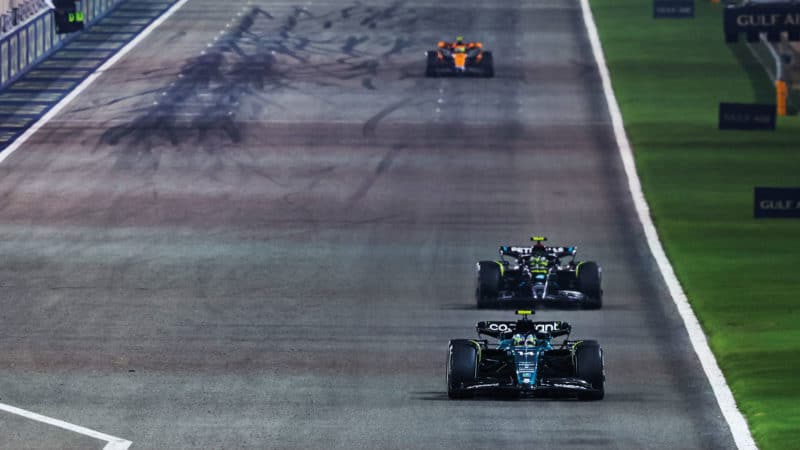
How much longer will either driver continue at the sharp end of the sport? For now, both are refusing to bend to the effects of age
DPPI
“I see myself being with Mercedes until my last days,” Hamilton said earlier this year. “If you look at the legends like Stirling Moss, he was with Mercedes until the end of his days and that has been the dream for me. I have that and just [want to] continue on with that and continue to build with the brand. As long as I can continue to help drive the team forwards, it’s where I want to stay. If there ever comes a time when I feel I am not able to do that, it is time for a youngster to come in and take my seat. But I am still feeling pretty young, in pretty decent shape.”
There have been signs of frustration from Hamilton this year, but these have to be viewed through the prism of his ambition and experience. The way he was deprived of an eighth title by race director Michael Masi’s freestyling with the rules in Abu Dhabi in 2021 is the entire context for Hamilton in F1 at the moment. That eighth title means a significant amount to him. He feels he should already have it. Mercedes feels it owes it to him. The two have a score to settle. So Hamilton’s disappointment when the car is not competitive hits hard.
“We’re still multi-world champions. We just haven’t got it right this year”
Each year he is not in a front-running car is a year he is not able to right what he perceives as that wrong. The comments that have created headlines this year – about not being listened to over the car design, or about the seating position being too far forward, making it difficult for him to feel connected with the car – are symptomatic of the situation, rather than an indication of a loss of faith in Mercedes.
As he put himself after the opening race of the season: “We’re still multi-world champions, you know? Just haven’t got it right this time. Didn’t get it right last year. But that doesn’t mean we can’t get it right moving forwards.”
“With Fernando and Lewis,” de la Rosa says, “the common thing is they are obsessed by their teams being competitive because they know if they deliver a winning car, they will win. On Fernando’s side, I think as long as the team has the ambition to win, he will keep going if he feels strong and competitive enough. With Lewis, it’s, ‘I will keeping going as long as the team is competitive or if I feel they can deliver a winning car.’ They won’t stop. They love the sport too much. That’s the reality.”
Andrew Benson is BBC Sport’s chief F1 writer
